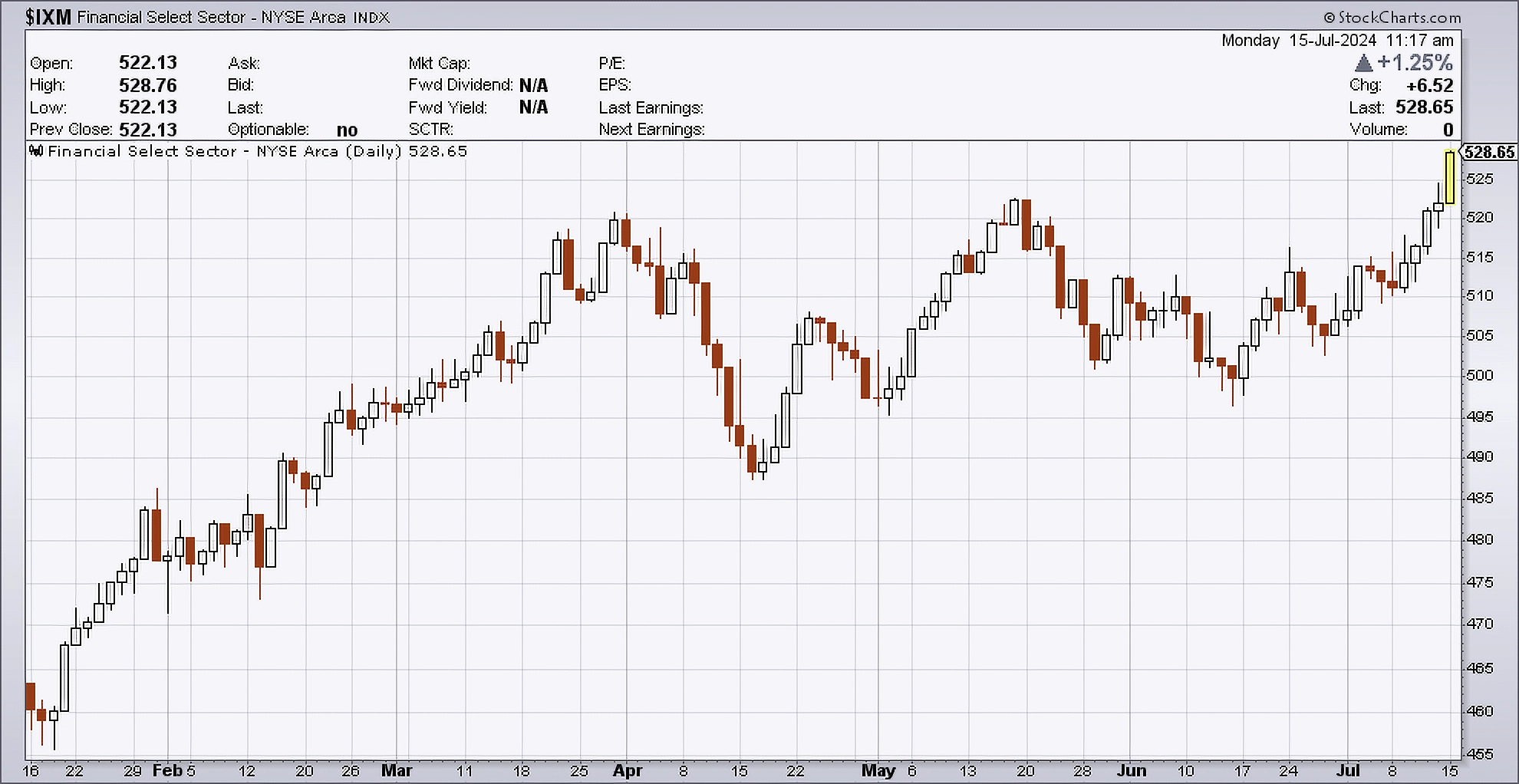Earnings Surprises: Can Traders Bank on Financials?

Editor's note: Any and all references to time frames longer than one trading day are for purposes of market context only, and not recommendations of any holding time frame. Daily rebalancing ETFs are not meant to be held unmonitored for long periods. If you don't have the resources, time or inclination to constantly monitor and manage your positions, leveraged and inverse ETFs are not for you.
Just in case you forgot, there are other stocks in the market besides the Magnificent 7. For example, the financial sector recently surged to all-time highs, driven in part by generally favorable first-quarter bank earnings.
Looking ahead, the sector's trajectory will hinge on several key catalysts, including potential Fed rate cuts, upcoming inflation* data, and the overall health of the U.S. economy.
Amid signs of a bit of a rotation away from mega-cap tech, the Financial Select Sector Index* recently notched a record high.
Below is a daily chart of the Financial Select Sector Index as of July 15, 2024.

Source: StockCharts.com, May 31, 2024.
Candlestick charts display the high and low (the stick) and the open and close price (the body) of a security for a specific period. If the body is filled, it means the close was lower than the open. If the body is empty, it means the close was higher than the open.
The performance data quoted represents past performance. Past performance does not guarantee future results.
Bank Earnings and Upcoming Economic Catalysts
Market indexes that track financial stocks are dominated by some of the largest U.S. banks. The recent breakout coincides with mixed second-quarter earnings reports from Citigroup (NYSE: C), J.P. Morgan (NYSE: JPM), and Wells Fargo (NYSE: WFC). Investors are focused on potential Fed cuts and if the health of big banks’ balance sheets will fuel concern about a slowing economy.
Indeed, financial stocks could see some volatility around the Fed’s two-day meeting scheduled for July 30–31. Recent signs of slowing inflation are fueling speculation that the Fed may start cutting rates as soon as this fall.
Aside from the upcoming Fed meeting, here are some economic reports that traders may want to circle on their calendars if they’re playing financial stocks:
- Employment: July U.S. non-farm payrolls, expected August 2
- Inflation: July Consumer Price Index (CPI)* report, expected August 10
- Producer prices: July Producer Price Index (PPI), expected August 11
- Economy: U.S. Gross Domestic Product (GDP) advance estimate for Q2, expected July 27
Berkshire and Other Key Earnings Reports
Berkshire Hathaway (NYSE: BRK.B) is the largest stock in the Financial Select Sector Index. Berkshire shares recently hit a new record high on confidence in Warren Buffett's leadership, Reuters reported.
The closely watched company is expected to release quarterly results in early August. Wall Street expects earnings of $4.29 a share from Berkshire, down from $4.62 in the second quarter of 2023, according to TipRanks. Analysts will be looking for updates on key sectors among Berkshire’s diverse portfolio of businesses such as insurance, energy, and consumer goods.
Elsewhere, financial stocks could also be swayed in coming weeks by quarterly earnings from two of the world’s largest credit card networks: Visa (NYSE: V) and MasterCard (NYSE: MA). The results should shed light on current consumer spending and digital transaction trends. Visa and MasterCard are expected to report around July 23 and July 31, respectively, according to TipRanks.
Trading Financials and Regional Banks With Leverage
For investors seeking to capitalize on financial sector movements, Direxion’s Daily Financial Bull 3X Shares (Ticker: FAS) and Daily Financial Bear 3X Shares (Ticker: FAZ) offer strategic options. FAS and FAZ seek daily investment results, before fees and expenses, of 300%, or 300% of the inverse (or opposite), respectively, of the performance of the Financial Select Sector Index. However, investors must understand the risks associated with leverage. While these ETFs offer potential for significant gains, they also pose substantial losses, making them suitable for those capable of managing leverage risks and targeting short-term trends in the financial sector.
For traders interested in regional banks, Direxion Daily Regional Banks Bull 3X Shares (Ticker: DPST) seeks to deliver daily investment results, before fees and expenses, of 300% of the performance of the S&P Regional Banks Select Industry Index*.
*Definitions and Index Descriptions
An investor should carefully consider a Fund’s investment objective, risks, charges, and expenses before investing. A Fund’s prospectus and summary prospectus contain this and other information about the Direxion Shares. To obtain a Fund’s prospectus and summary prospectus call 866-476-7523 or visit our website at www.direxion.com. A Fund’s prospectus and summary prospectus should be read carefully before investing.
Leveraged and Inverse ETFs pursue daily leveraged investment objectives which means they are riskier than alternatives which do not use leverage. They seek daily goals and should not be expected to track the underlying index over periods longer than one day. They are not suitable for all investors and should be utilized only by sophisticated investors who understand leverage risk and who actively manage their investments.
The Financial Select Sector Index is provided by S&P Dow Jones Indices (the “Index Provider”) and includes securities of companies from the following industries: Banks; Thrifts & Mortgage Finance; Diversified Financial Services; Consumer Finance; Capital Markets; Insurance; and Mortgage Real Estate Investment Trusts (REITs).
The S&P Regional Banks Select Industry Index (SPSIRBKT) is a modified equal-weighted index that is designed to measure performance of the stocks comprising the S&P Total Market Index that are classified in the Global Industry Classification Standard (GICS) regional banks sub-industry.
One cannot directly invest in an index.
Each of the “S&P Regional Banks Select Industry Index” and the “Financials Select Sector Index” is a product of S&P Dow Jones Indices LLC (“SPDJI”), and has been licensed for use by Rafferty Asset Management, LLC (“Rafferty”). Standard & Poor’s® and S&P® are registered trademarks of Standard & Poor’s Financial Services LLC (“S&P”); Dow Jones® is a registered trademark of Dow Jones Trademark Holdings LLC (“Dow Jones”); and these trademarks have been licensed for use by SPDJI and sublicensed for certain purposes by Rafferty. Rafferty’s ETFs are not sponsored, endorsed, sold or promoted by SPDJI, Dow Jones, S&P, or their respective affiliates and none of such parties make any representation regarding the advisability of investing in such product(s) nor do they have any liability for any errors, omissions, or interruptions of the S&P Regional Banks Select Industry Index or the Financials Select Sector Index.
Direxion Shares Risks – An investment in each Fund involves risk, including the possible loss of principal. Each Fund is non-diversified and includes risks associated with the Funds’ concentrating their investments in a particular industry, sector, or geographic region which can result in increased volatility. The use of derivatives such as futures contracts and swaps are subject to market risks that may cause their price to fluctuate over time. Risks of the Direxion Daily Financial Bull 3X Shares and Direxion Daily Financial Bear 3X Shares include Effects of Compounding and Market Volatility Risk, Leverage Risk, Market Risk, Counterparty Risk, Rebalancing Risk, Intra-Day Investment Risk, Other Investment Companies (including ETFs) Risk, Cash Transaction Risk, Tax Risk, and risks specific to the securities of the Financial Sector. Performance of companies in the financials sector may be materially impacted by many factors, including but not limited to, government regulations, economic conditions, credit rating downgrades, changes in interest rates and decreased liquidity in credit markets. Additional risks include, for the Direxion Daily Financial Bull 3X Shares, Daily Index Correlation Risk, and for the Direxion Daily Financial Bear 3X Shares, Daily Inverse Index Correlation Risk, and risks related to Shorting.
Risks of the Direxion Daily Regional Banks Bull 3X Shares include Effects of Compounding and Market Volatility Risk, Leverage Risk, Market Risk, Counterparty Risk, Rebalancing Risk, Intra-Day Investment Risk, Daily Index Correlation Risk, Other Investment Companies (including ETFs) Risk, Cash Transaction Risk, Tax Risk and risks specific to the securities of the Banking Industry and Financials Sector. Companies within the banking industry can be significantly affected by extensive governmental regulation, which may limit both the amounts and types of loans and other financial commitments they can make and the interest rates and fees they can charge and amount of capital they must maintain.
Please see the summary and full prospectuses for a more complete description of these and other risks of the Funds.
Distributor: Foreside Fund Services, LLC.